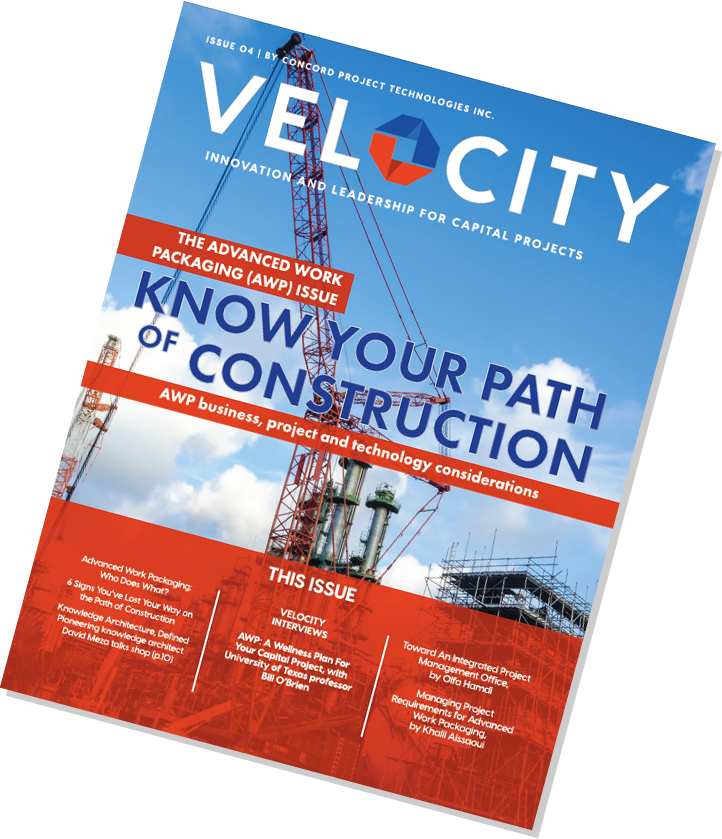University of Texas professor Bill O’Brien explains how Advanced Work Packaging (AWP) has the power to create healthy, sustainable capital project organizations
 Professor Bill O’Brien is a professor at the University of Austin at Texas and has long worked with both Fiatech and the Construction Industry Institute (CII). He was a member of the CII research team that produced IR-272, and is now leading a team of researchers working to improve integration of supply chain in materials planning and work packaging. This interview has been lightly edited and condensed for clarity.
Professor Bill O’Brien is a professor at the University of Austin at Texas and has long worked with both Fiatech and the Construction Industry Institute (CII). He was a member of the CII research team that produced IR-272, and is now leading a team of researchers working to improve integration of supply chain in materials planning and work packaging. This interview has been lightly edited and condensed for clarity.
VELOCITY MAGAZINE:Why do we need Advanced Work Packaging?
BILL O’BRIEN: The complexity of the modern construction site has made it very easy to get away from good management practice. This is in part due to silos and the difficulty of aligning all the stakeholders and processes needed to accomplish a project. In response, AWP is a holistic program that enforces good fundamentals by bringing all the project pieces together in one place, so you can make effective decisions and engage in effective planning all the way from the front end through execution. To me, that’s AWP in a nutshell.
VM: What are the impediments to adopting AWP?
O: People who don’t know a lot about AWP are under the mistaken impression that it will be a new and difficult. They hear the consultants saying: “That’s just a start, there are all these other things you need to do,” and they start talking about PWPs and turnover work packs and more new concepts. For people on the outside, it looks like a great big complex mystery. What does that do? What does it mean? The reality is so much simpler: The whole point of AWP is to enforce what we all know to be good practice, and what we all know is good for the project. It’s just gotten out of control on a lot of modern projects, and we need extraordinary measures to put it back into place.
VM: How did we get to a point where we need “extraordinary measures” to put best practices in place?
O: There’s no simple answer to that. We’ve made projects more complicated, we haven’t invested in our workforce as much as we should, and we’ve not been very good about adopting technologies that deal with that complexity. At some level we’ve accepted poor practice. It has become the norm.
VM: Why have capital project organizations been slow to adopt technology?
O: I don’t think there’s an easy answer. People are interested in adopting technology that’s clearly going to help them. Because capital projects are so complex, it has been difficult for software solutions to issue a complete solution… Every company has its own systems, its own ways of working, and new technology is seldom a complete replacement. It can make things more complicated, rather than less complicated.
VM: Why do capital project organizations need to invest in technology as part of their AWP strategy?
O: AWP in practice forces consumption of information. Particularly on the workface planning side, for an Installation Work Package, requires pulling together information from a lot of sources: contract status, drawing status, material status, equipment status, labor status. It’s forcing all that information together, combining it from multiple systems. AWP requires information integration. Ideally integration is automatic — particularly during construction execution, on the front-end perhaps it can be done more manually. But it still requires all the stakeholders to come to the table and share information. For AWP to be successful, a prerequisite is being able to make information available for successful decisions.
At some level, we've accepted poor practice. It has become the norm.
Bill O'Brien Tweet
VM: How common is miscommunication on capital projects?
BO: It happens all the time. It’s more the norm, rather than the exception, and that’s both within and across companies. You see siloed information, and siloed areas of expertise. Some people talk about breaking down silos, but perhaps a more nuanced way is to say that we need to connect the silos better. That’s a huge challenge.
We’ve got some self-assessment data from organizations that show they’re not satisfied with their visibility into project information, and they are not satisfied with their ability to trust that information, either. So there are two issues: One is the difficulty of accessing the information, and the second issue is, once you have it, do you really trust it? … There are so many different places that information can reside, and different versions, that without a single source of truth (SSOT) it is hard for anyone to trust that what they have is really up-to-date.
VM: Could you expand on your thinking around the “single source of truth?”
BO:It’s the one place where everybody can go for trustworthy data. Every project is going to have some version of this, whether it’s an individual, or a trusted schedule, or a tool they use to get the information. Currently, the SSOT can often be at an organizational level, not at the project level, and then the challenge becomes managing information across the project participants. For example, a company might have a good materials management database that is kept up to date and everybody trusts it, but that’s only for use inside the company, and how do we share it? … Almost every company has its own data system(s), and getting all those to communicate with each other is a challenge.
VM: Who should be responsible for integrating information on capital projects?
BO: Ideally that lies somewhere with the EPC contractor. The Owner has to participate in that as well. Contracts need to promote information sharing, and that needs to be the standard as opposed to the exception. When a project is formed, it needs an information plan. That plan needs to be aligned with the contractual expectations as well. When either of those is not there, it’s not going to go well.
In addition, there does have to be some mindset change in the industry, so people come to believe that sharing information is good. At some level you have people worried about losing power or losing control — there is some culture shift required around that as well.
VM: What are the top four actions a company can take to start moving in the right direction with AWP?
BO: First realize that it’s a journey, it’s not just a destination. These are systemic problems we have in the industry, and it requires systemic solutions. AWP is an overall wellness plan.
1 | Do a self-assessment and pick things that can be early wins for your organization.
It’s likely you’ve got various improvement programs going on anyway, if you can wrap these things up together with AWP, that’s good. Figure out what the low-hanging fruit is for your organization.
For a contractor, low-hanging fruit is just getting your own site together, putting in installation work packages, getting the AWP champions in place. I don’t want to trivialize this — it will be a challenge — but if it’s largely in the contractor’s control they’ll see some immediate benefit. You might see 10% gains, because you’ve done better planning, and that should more than pay for itself. Then you’ll realize that to get the next level of gains, you’ll have to tie together with other organizations upstream and downstream, and that’s much harder.
So choose an implementation path where your company has the span of control to be successful. For different companies, it will be different things.
2 | Realize that anything new you do is going to cost some money, so make sure it’s funded and resourced well.
A lot of attempts at AWP are bootstrapped, and they don’t work well. If you’re going to give it a try, resource it correctly. Make sure people have it in their job description — you can’t just add things on to a project and expect it to happen. You’re going to have to make a corporate investment, it will probably pay for itself in your first project. However, because of the way we do accounting, it’s not very obvious.
We can always see the cost of something, we can’t always internalize the benefits very easily. … That’s often why we say that the AWP needs to be Owner-led because the owner can help people get around those issues and ensure they are working for the good of the project.
3 | Identify your champions and make sure they’re backed by your executive team.
The skunk-works type of projects only go so far without some kind of official investment. … Good champions have passion, belief, influence and time to make things work. It’s always difficult to make changes and upper-management support is so important. Champions need to be somebody that people will listen to — at some level, they need to have the power to make changes, but really they need the skills to be able to get others to invest in the system.
4 | As an owner who wants this to happen, you want to level the playing field contractually.
You just don’t want to say: “Do AWP.” You want to think through what your requirements are, and that allows for the firms to bring you their best. A few years ago I was at a conference, and an executive from a major oil company was speaking, and he said what they’ve done with their external contractors is they’ve tried to make it very explicit what they want and that they’re willing to pay for the up-front planning and staffing costs that come with Advanced Work Packaging because they know that they’ll see the benefit.
He said that without that kind of leveling the playing field by being explicit to what they want, what would happen is that some firms would be hesitant to put AWP in bids, because that would be a little bit more expensive in the staffing costs, and they didn’t want to be disqualified.
Really, Owners are the ones that should see the most benefit out of this. If you want all the benefits of AWP in your projects, be explicit about what you want, and allow contractors to give you their best efforts and not feel that they’re going to be disqualified for being a little bit more expensive.
VM: Where is the capital projects industry heading?
BO: Folks coming out of school today are more tech-savvy, so this information-sharing culture is going to be a lot easier than it has been for earlier generations. I do think AWP is a wellness program to improve how we work now. AWP is also a path towards more holistic execution. That said, a path forward for our industry is to reduce the complexity of the various interfaces that we have on projects. One concept there is more extensive use of standardization (which still can allow for customization). … Similarly, you’re probably going to see some realignment of industry structure to firms that are much more integrated. … You see hints of that in the industry already. Technology – physical parts and information bits – is going to fit together in a much more standardized way, and that’s going to reduce a lot of the management oversight and associated complexity.
You see a few firms out there that are doing things like that. … A much more aggressive use of technology using it in a very integrative and thoughtful way to really connect the building design with the actual construction. … The model-based world is coming. One thing you hear about now is the concept of the digital twin – a facilities model that supports design, construction and operations. Operations utilizing and demanding digital models are going to help pull good information deliverables from concept and that can only help projects.
VM: Any closing thoughts?
BO: There’s a need for the industry to really step back and make improvements. Sometimes we feel like we’re charging forward so fast all the time, people don’t take the time to actually improve. AWP forces that introspection, and that can be really valuable.





